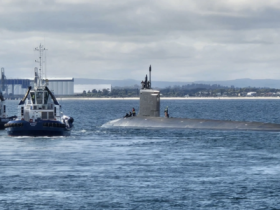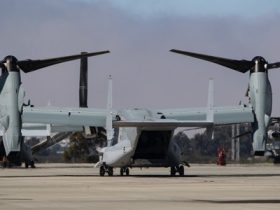Milton intensifies: Florida residents in the vicinity of Tampa Bay are under new evacuation alerts after Hurricane Milton quickly strengthened Monday into a category five storm headed for the Florida coast. In the hours since, however, it has reduced somewhat into a category four storm expected to make landfall in Florida on Thursday.
Latest: “Milton has the potential to be one of the most destructive hurricanes on record for west-central Florida,” the National Hurricane Center said Tuesday. On Monday, it reached a maximum intensity of 180 mph, “making it one of the most intense Atlantic Basin hurricanes on record,” according to the Weather Channel.
New: Personnel on MacDill Air Force Base are under a limited evacuation order, with basewide closure expected later today. MacDill, which is home to U.S. Central Command and U.S. Special Operations Command, is situated on a peninsula between St. Petersburg and Tampa—almost directly in the path of Milton as it’s projected to sweep northeast toward Orlando and Daytona Beach.
Evacuations began Monday, base officials said in a video on Facebook. The airfield itself is already closed. The base commissary and Post Exchange are closing today at 12 p.m. ET.
Portions of seven surrounding counties are also under that limited evacuation order. For more details, you can read over the order (PDF) here.
Meanwhile in North Carolina, portions of the 101st Airborne Division are going house to house to find out what storm-hit families need, Liz Friden of Fox reported from Garren Creek, near Asheville. “Once checked, the soldiers tied a pink ribbon on the houses to mark they had what they needed and told residents they would come back in a few days,” said Friden’s colleague, Jenn Griffin.
Welcome to this Tuesday edition of The D Brief, brought to you by Ben Watson with Bradley Peniston. Share your newsletter tips, reading recommendations, or feedback here. And if you’re not already subscribed, you can do that here. Happy 134th birthday to aviation pioneer Eddie Rickenbacker.
Ukraine is keeping up its campaign of attacking Russia’s oil infrastructure, including an early morning strike Monday at a large terminal in occupied Crimea. Troops with Kyiv’s missile forces carried out the attack, Ukraine’s General Staff said on Facebook.
“The Feodosia terminal is the largest in Crimea in terms of transshipment of oil products, which were used, in particular, to meet the needs of the occupation army of the Russian Federation,” the military said in a statement Monday. A bit more, here.
Invasion latest: “Russian troops have now entered Toretsk, a strategic hilltop city, and are pressing with assaults elsewhere in the Donetsk region,” the New York Times reported Tuesday from Kyiv. “To seize the remaining third [of Donetsk], it would need to break through several Ukrainian defensive lines of trenches and anti-tank ditches, and battle its way through densely populated urban centers — a grueling fight that U.S. officials believe the Russian army cannot successfully wage in the short term.”
ICYMI: Russia downed one of its prototype UCAVs over Ukraine. Why? In what The War Zone described as “a bizarre situation,” a Russian fighter jet fired a missile at a S-70 Okhotnik-B flying-wing unmanned combat air vehicle on Saturday, downing it miles behind the Ukrainian front line. The UCAV was carrying at least one precision glide bomb, leading to speculation that it was on some sort of operational trials. Purported photos of the downed S-70 are here, and you can read more, here.
Iran apparently has China’s Silent Hunter anti-drone laser system. The system, which can dazzle or possibly even damage incoming UAVs, made a cameo appearance as part of security measures around a rare public sermon by Iran’s Supreme Leader Ayatollah Ali Khamenei. (The War Zone)
Additional reading: “N. Korea likely to send troops to Ukraine in support of Russia: S. Korea’s defense chief,” South Korea’s Yonhap news agency reported Tuesday.
Is ‘Big AI’ beating ‘small AI’—and what does that mean for the military? The prevailing “bigger-is-better” approach to artificial intelligence—ingest more training data, produce larger models, build bigger data centers—might be undermining the kind of research and development the U.S. military actually needs now and in the future. That’s the argument in “Hype, Sustainability, and the Price of the Bigger-is-Better Paradigm in AI,” a new paper that scrutinizes common assumptions driving AI research. Defense One’s Patrick Tucker unpacks that, here.
Diego Garcia negotiations update: No “foreign armed forces.” One week after the British announced plans to relinquish sovereignty over a small chain of islands in the Indian Ocean—except for one with a 99-year lease—the UK’s top diplomat said Mauritius has agreed to new terms that include “preventing foreign armed forces from accessing or establishing themselves on the outer islands” known collectively as Chagos, British Foreign Secretary David Lammy announced Monday.
Chagos includes the island of Diego Garcia, which hosts an obscure yet key outpost for the British and U.S. militaries, as many folks with a naval background are apt to tell you. (That’s the island with the nearly century-long exemption from Mauritian sovereignty.) Self-declared “right of center” U.S. naval blogger Cdr. Salamander was particularly aggrieved over the surprise developments when Lammy first announced them last week. An “epic own-goal” is how Salamander described the new direction from the Brits, alleging they seem to get a “masochist’s thrill from damaging themselves and their nation.”
Some history: The Brits occupied Diego Garcia during the Cold War in a process that ran afoul of the United Nations, forcibly displacing at least 2,000 locals to make room for a naval base. Its location was especially useful later during the U.S.-led Global War on Terror, and British and U.S. officials are keen to not lose that perk—even though it comes with the baggage of that bygone era of colonialism. Contemporary British officials are trying to thread the needle of shedding some of that baggage while also retaining the strategic benefits of the naval base’s geography. That’s why the Brits announced last week the islands were indeed Mauritius’s sovereign territory, but that the Brits don’t plan to depart the base at Diego Garcia until at least another 99 years.
The other big fear? Chinese developers would very likely step in where the Brits and U.S. depart. That helps account for the language from Lammy about “foreign armed forces” on Monday.
“From countering malign Iranian activity in the Middle East to ensuring a free and open Indo-Pacific, [Diego Garcia] is critical for our national security,” Lammy reminded British lawmakers Monday. “Without surety of tenure, no base can operate effectively—nor truly deter our enemies.”
Perhaps more importantly, at least in the short term, continuing to occupy Diego Garcia without agreeable terms from Mauritius, “undermined our international standing,” Lammy said Monday. With the updated terms, “We are showing that what we mean is what we say on international law and desire for partnerships with the Global South,” which “strengthens our arguments when it comes to issues like Ukraine or the South China Sea,” he said.
Next steps: “After Mauritian elections, the government will move towards treaty signature” to formalize the new terms, the foreign secretary said. Afterward, “it is then our intention to pursue ratification in 2025, by submitting the Treaty and a Bill to [the House of Parliament] for scrutiny,” he said
In the meantime (emphasis added), “Mauritius is now free to implement a resettlement programme to islands other than Diego Garcia,” which “has an uncontested long-term future…under full UK control well into the next century,” said Lammy.
Read the full article here








Leave a Reply